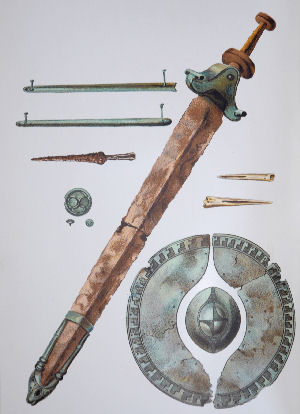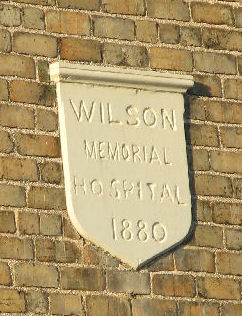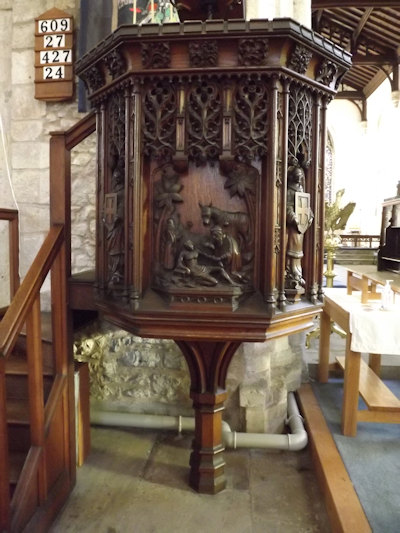|
  Dr. Thomas Wilson was the Pocklington doctor and Physician for over 40 years and was a noted antiquarian and local historian. He was present at the most important digs by the famous Victorian Archaeologist J.R. Mortimer, who excavated many of the Wolds bronze age barrows. Mortimer called upon Dr. Wilson whenever he needed expert medical opinion when he discovered skeletal remains. Dr. Wilson excavated the famous Grimthorpe sword that is the fronticepiece of Mortimers's classic work "Forty Years researches in British and Saxon Burial mounds in East Yorkshire" Dr. Thomas Wilson was the Pocklington doctor and Physician for over 40 years and was a noted antiquarian and local historian. He was present at the most important digs by the famous Victorian Archaeologist J.R. Mortimer, who excavated many of the Wolds bronze age barrows. Mortimer called upon Dr. Wilson whenever he needed expert medical opinion when he discovered skeletal remains. Dr. Wilson excavated the famous Grimthorpe sword that is the fronticepiece of Mortimers's classic work "Forty Years researches in British and Saxon Burial mounds in East Yorkshire"
Pocklington had a thriving Philosophical and debating society which would meet and have lectures on all topics of art, literature and history, of which Dr. Wilson was a key member. He was born in Walkington, the son of Thomas and Elizabeth Wilson and was baptised in Walkington on the 2nd September 1805. In 1831 he graduated from Edinburgh University.
 Wilson arrived in Pocklington in the mid-1830s after qualifying at medical school in Edinburgh and London, coming to his uncle’s practice at Oak House in the Market Place, the home and surgery of the Bell family of coopers and doctors since the late 1600s. Wilson arrived in Pocklington in the mid-1830s after qualifying at medical school in Edinburgh and London, coming to his uncle’s practice at Oak House in the Market Place, the home and surgery of the Bell family of coopers and doctors since the late 1600s.
In the 1841 census he was practicing medicine as the town’s doctor in the Oak House (the present Arts Centre) and lived there until his death On June 19th 1878 at the age of 72. Through his friendship with the Singleton racing dynasty, was also in demand with racing stables as a horse doctor, becoming the ‘personal physician’ to legendary Derby winner, Blink Bonny.
He was a leading figure of many Pocklington organisations and institutions, owned property in the town in addition to Oak House, plus land, being a noted breeder of pedigree sheep. Oak House had stables and extensive gardens at the back, where Wilson entertained guests, including close friend, the artist William Etty
I have not found any evidence of a marriage or children. A new pulpit of oak was built for Pocklington church, richly carved by Messrs. Elwell, of Beverley, at the cost of 100 guineas, in his memory. A plaque on the pulpit reads "In memory of Thomas Wilson M.D., died 1879." The money was raised by public subscription, and the panels were designed by Mr. Temple Moore. The old pulpit was used by the church at Little Driffield and is still there today.
A building originally erected in 1880 for the purposes of a hospital, in memory of the late Thomas Wilson M.D. of Pocklington had six beds, closed soon after and became a private residence.
The Wilson Memorial Reference Library was established with part of the funds collected to found the Wilson Memorial Hospital. A memorial plaque appears on a house in South Parade, the site of the Cottage Hospital.
He had been the first person called for when the Sotheby Cross was discovered in the churchyard in 1835, and the fund paid for a local stonemason to mount the Medieval cross-head on the current base and shaft in 1879, after it had been abandoned in a corner for decades. Dr. Wilson was of the firm opinion that Pocklington was the site of the assembly of King Edwin in 627, after which followed the destruction of the Pagan Temple at Goodmanham and led to the establishment of Christianity in the Northern Kingdom. It is commonly stated that Aldby, Buttercrambe was where this took place. If true, and his arguments seem persuasive, makes Pocklington an important centre for early Christanity. See the Soteby Cross page for more information.
There may be a surviving photograph of Dr. Wilson, as I was contacted around 2005 by a person in South Africa (Derek Mauleverer Porter) who told me he had one in his mother's possessions, but unfortunately I learned later that the gentleman had died soon after contacting me. A portrait painting may exist which in the effects sale notice was sold to the family for £32, it is believed to be by the artist Charles Lees.
n.b. There is confusion about the birthplace of the famous York painter William Etty which the journalist in the article in the York Herald here incorrectly ascribes to Pocklington. The confusion may have been caused by the fact that the first child, born to Matthew and Esther Etty (William Etty’s parents) was a William. His birthplace is not known, so far, but it may be Pocklington where they lived for a while after their marriage. The first William, born in 1772, died in York in 1774, three years before William Etty was born. William Etty has published a short autobiographical sketch in the Art Journal, briefly before his death, which starts as follows:
‘Like my favourite hero, Robinson Crusoe, “I was born in the year ----, in the city of York.”So he says- so say I, only he was born in 1632, I in 1787, March 10, of an honest and industrious family.’
|

